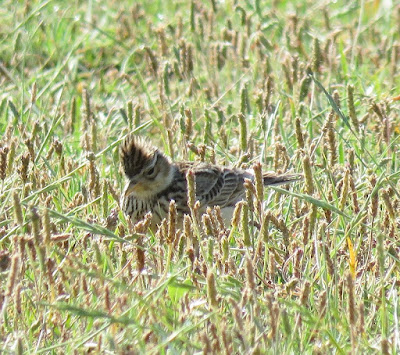Andy Field was keeping a watch over the park wildlife over the last couple of weeks whilst I went away for some proper sunshine. He supplied me with a selection of wildlife shots taken from the park recently.
The great news that common terns had bred for the first time at the park was tempered by the sad news that the only chick was seen being snatched by a carrion crow on Sunday 3rd. The picture above which shows the small brown chick on the left side was taken only an hour before Andy witnessed the snatch.
The great news that common terns had bred for the first time at the park was tempered by the sad news that the only chick was seen being snatched by a carrion crow on Sunday 3rd. The picture above which shows the small brown chick on the left side was taken only an hour before Andy witnessed the snatch.
Nearby on the same saltmarsh pools were at least three sitting avocets with up to 20 birds present in total. Three redshank chicks from two different families were also seen.
Two kestrel chicks could be seen inside the nestbox at the back of the park fields on 21st June. At least three chicks have since fledged from the box.
A hobby was seen over the horse paddocks to the north of the park around the same date.
On the 15th June a hobby was also seen over the park's grazing fields and then at the end of the day a barn owl was hunting fields to the north of the park.
Near West Mersea a pair of turtle doves were seen in Cross Lane by Martin Cock in late June.
A hobby was seen over the horse paddocks to the north of the park around the same date.
On the 15th June a hobby was also seen over the park's grazing fields and then at the end of the day a barn owl was hunting fields to the north of the park.
Near West Mersea a pair of turtle doves were seen in Cross Lane by Martin Cock in late June.
A young grey heron has been a regular sight at the park over the last month or so.
The mute swan family still have all seven cygnets along the park dyke.
Several pairs of coots have young with some pairs onto their second brood already.
Several common whitethroats can still be heard singing from the tops of bushes at the park.
Reed warbler numbers have been down in numbers this year, this one singing from reeds along the park dyke.
Several skylarks can still be heard singing in the skies over the park, and sometimes they can be seen feeding on the ground too.
The recent wet weather has been kind to song thrushes as they're able to find more food such as worms and snails.
The first ringlets seen at the park this year was on the 3rd July. A clouded yellow was seen near the Oyster Fishery on the same day
Lots of blue-tailed damselflies can be seen resting on vegetation near the water as well as alongside some of the paths in the park.
This mining bee was spotted on the seawall near the Point covered in pollen.
Another of the mining bees without pollen.
This bird pellet was found on top of a kissing gate on the seawall near Reeveshall which when pulled apart, was found to be full of earwigs, probably ejected from a bird like a crow.















No comments:
Post a Comment